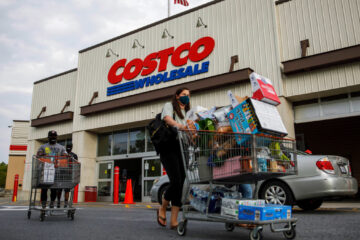Looks like we made it.
January is over, and to those of you who recognized the title of Barry Manilow’s 1977 song, sorry about the earworm.
💵💰Don’t miss the move: Subscribe to TheStreet’s free daily newsletter 💰💵
But this is an important time of the year as we all make way for February.
For instance, it means the end of Dry January, where people abstained from alcohol during the Wolf Month, as the Saxons used to call it–and after 31 days of no booze, there are probably many people out there howling.
In 2024, 25% of U.S. adults participated in Dry January, up from 16% in 2023.
The end of January is also an important time in the world of finance as market analysts keep an eye out for the January Barometer.
Related: Every major Wall Street analyst’s S&P 500 forecast for 2025
As any meteorologist will tell you, barometers measure air pressure to forecast short-term changes in the weather.
High pressure is usually associated with clear skies and cool, dry air, while low pressure indicates cloudy, rainy, and windy weather.
The January Barometer is a theory that says the investment performance of the S&P 500 in January is representative of the predicted performance of the entire year.
The theory says that if stocks are higher in January, they should be higher for the year, and if they are lower in the first month, they’ll be lower for the year.
The S&P 500’s performance in January offers clues to what may happen to stocks for the remainder of 2025.
Michael M. Santiago/Getty Images
January Barometer has good track record
The S&P 500 finished down on Jan. 31, but the broad market ended up 2.6% for the month, so maybe we should heed the words of Wall Street legend Yale Hirsch, who first came up with the concept in 1972 in his Stock Trader’s Almanac, a widely read investment guide.
He’d been involved in investment research for years and, armed with a background in music, discerned the pattern.
More 2025 stock market forecasts
Veteran trader who correctly picked Palantir as top stock in ‘24 reveals best stock for ‘255 quantum computing stocks investors are targeting in 2025Goldman Sachs picks top sectors to own in 2025Every major Wall Street analyst’s S&P 500 forecast for 2025
Hirsch, by the way, also gave the world the Santa Claus Rally, which describes a rise in stock prices during the last five trading days in December and the first two trading days in the following January.
Analyst Stephen Guilfoyle said early this month in a post for TheStreet Pro that Santa Claus posted a loss this year, which was Santa’s second consecutive year in the red.
“No sweat,” the veteran trader said in his Jan. 9 TheStreet Pro column. “That’s just a seasonal trade, and 2024 was a very nice year for U.S. equities in a broad sense.”
The almanac also developed the Early Warning System, a subset of the January Barometer, which states that an S&P 500 gain in the five days of January is a good sign for the year.
Guilfoyle, whose career dates back to the New York Stock Exchange floor in the 1980s, had an opinion on what he called the First Five Days indicator.
“I think it’s merely coincidence, but like the Santa Claus rally and the January Barometer, the legend seems to work about three-quarters of the time, at least since I’ve been in the markets professionally, which is almost a 40-year period,” he said.
The Stock Trader’s Almanac said the January Barometer has been right 84% of the time since 1950.
The theory worked just fine in 2023 and 2024. The S&P 500 was up 6.2% in January 2023 and ended the year up 24.3%. In 2024, the S&P 500 finished January with a relatively modest 1.02% gain. The gain for the year totaled 23.3%.
And the barometer also worked in the bad 2022 market, when the index started the year off by falling 5.3% and ended the year down 19.44%.
Critics of the January Barometer say it has had an inconsistent track record.
They also cite the possibility of the phenomenon being a coincidence while noting that similar patterns haven’t been consistently observed in other global markets, which would suggest that it might be a unique anomaly to the U.S. stock market;
Still, Ryan Detrick, chief market strategist at Carson Group, was feeling pretty good about the 2025 January Barometer.
Analyst warns gains will be tougher to come by
“Best January for the S&P 500 since 2023. Late-day sell-off erased the 3% monthly gain, but >2% first months tend to still be quite strong for the full year,” wrote Detrick on X, formerly Twitter. “Full year up 18.4% on avg and higher nearly 88% of the time.”
Related: Fed officials’ frank words reset interest rate forecasts
January has been exciting as Donald Trump returned to the White House vowing to overhaul the federal government.
And the stock market hit a phenomenally rough patch with the arrival of DeepSeek, a free AI-powered Chinese chatbot whose creators claim can do the work of its much more costly rivals,
DeepSeek’s debut triggered a monstrous stock-market selloff that butchered the value of some of the biggest names in tech, including AI chipmaking Godzilla Nvidia (NVDA) .
“In the short run, I think people are going to be a little skeptical because they saw stocks get hammered immediately on the DeepSeek news,” said Ash Shah, senior portfolio manager with Invesco’s Discovery Growth team. “But then a rebound came the next day. So, I think people are going to come to realize that this is an evolutionary thing, but it’s not a revolution.”
Jeffrey Hirsch, Yale Hirsch’s son and the editor-in-chief of the Stock Trader’s Almanac, said 2025 is tracking the bullish post-election trend so far this year.
“Our January Barometer will be positive unless the S&P 500 drops 189.55 points today,” Hirsch said on LinkedIn, which it definitely did not do.
Hirsch warned that gains this year will be tougher to come by, though, and shallower than the past two years.
“Our 2025 annual forecast for 8-12% gain with a lot of chop and weakness in Q1 and Q3 is on target,” he said. “Post-election years have been much better in recent years, but Q1 is a weak spot.”
Hirsch told investors that they should expect more volatility and chop in the near term.
“February has been notoriously weak and even more so in post-election years,” he said. “February is the worst month for S&P 500, NASDAQ and Russell 2000 in post-election years since 1950.”
Related: Veteran fund manager issues dire S&P 500 warning for 2025


